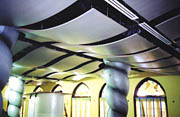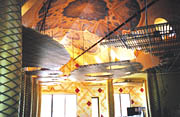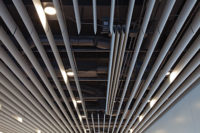

Today, architectural expression is often pushed to the limit in order to achieve innovative and progressive design statements. As a result, the application and installation steps involved in non-traditional design specifications become more of a challenge. Proactive assistance and communication efforts are crucial through each level of development in order to execute and deliver a successful project.
A recent ceiling installation in Annabelle’s Restaurant, of Naples, Fla., is an example of how we as a manufacturer coordinated with the architectural firm, developer and contractor during the architectural, manufacturing and installation process, to ensure a successful project.
Architectural approach
The union between us, ceiling manufacturer, Rulon Co., of Brunswick, Ga., and the architectural firm, Studio Arquitectura Inc., of Santa Fe, N.M., meant both groups had to design a creative and functional statement. The architects envisioned two unique ceiling approaches for two different dining areas. The owner’s intent was to create a comfortable, plush, residential appearance that instilled the essence of coastal Florida.“The lower level needed to be representative of movement,” says Glynn Gomez, interiors architect of Studio Arquitectura Inc. “There needed to be a sense of being within or below the water.”
Rulon Veneer Curvalon panels were chosen for the lower level to reflect the color and the shape of ocean waves. Installed using layouts we generated, the open areas between the panels allow acoustical channels to provide superior sound properties.
“Typically, an installation of ceiling components of this caliber would require additional fieldwork and preparation,” according to installation contractor Andy Irvine, of Lotspeich Company Southwest Inc., of Fort Myers, Fla. “But early manufacturer involvement minimized this.”
The upstairs dining area was to give the illusion of clouds in the sky, moving slightly with the breezes. The clouds required pre-cut Panel Grille sections, suspended from the 30-foot domed ceiling, thus heightening the challenge from an installation standpoint.
“The use of clouds supports an image of the serenity of the Florida sky,” Gomez adds. “The selection of the type of product used guaranteed the functional qualities desired to create our image.”
As the manufacturer, we addressed the architect’s concepts, developed the actual ceiling components, prepared shop drawings and installation steps, and visited the job site to conduct instructions. As a result, actual installation was the remaining use of time and resources after these steps were complete. Addressing each of these levels, in coordination with other project players, established a scenario where 80 percent of efforts involved manufacturing and 20 percent was fieldwork. A typical scenario usually features reverse percentages.
“Rulon asks you to come to the table and spill all your design concepts out about the project,” says Gomez. “Then they tell you what to do and how to go about it. They really understand their systems and how to apply them to a project. We received more assistance than we bargained for.”
This hands-on system also makes the process smooth for the contractor.
“Probably the most difficult part of any project is the front-end coordination between designer, manufacturer and the installer,” adds Irvine. “The extensive coordination with plans, layouts and product design made our installation virtually mistake free.”
Annabelle's upper dining area
To comply with the owner’s design theme and to maximize the functionality of the ceiling, a suspended Panel Grille design was used.Installation of Panel Grille ceiling sections formed in the shape of clouds suspended from the restaurant’s 30-foot-high ceiling reveal a painted tapestry molded to the domed ceiling. This created a challenge in the installation process. The initial design was to have standard uniformed-length panels from the factory. This approach would have required extensive fieldwork for the installer to assemble panels, cut them into designed shapes, and install multiple layers of perimeter trim to cut ends.
The solution to the problem was to create custom panels that, once assembled according to the prepared key plan indicating sequential placement of panel sections, would meet the architect’s design expectations. From an installation standpoint, no cutting, trim attachment or specialty work was required at the job site. The installation contractor only had to hang factory-manufactured custom panels. Mechanics were able to mark the hanger wire locations with lasers based on detailed layout plans provided by the manufacturer. A strong emphasis on accuracy of placement and extension of hangers was necessary to accommodate projected airflow to be used to give movement to the “cloud formed” grilles.
Annabelle's lower dining area
Curvalon panels were utilized in the lower dining area because they offered the owner and architect greater “freedom of form” in their design specifications. The curved panels also provided a simplified solution in minimizing exposed electrical and air duct components while allowing strong acoustical properties.Architectural, engineering and manufacturing staffs were also just as closely involved with Annabelle’s representatives and installation team for the first floor dining room ceiling. This room required a smooth, continuous flow of curves from one end of the building to the next. The coordinated efforts from the two teams resulted in good manufacturing yields, appropriate spacing between panels to achieve acoustical desires and minimal labor steps at the job site.
“This project was very complex with high-end finishes, small areas to work with and many trades working in the same area,” Irvine says. “A fairly aggressive schedule and quite a few changes from designer and owner also added to the complexity.”
The overall procedure was simplified by the extent to which manufacturing, custom finishes and packages went prior to shipment.
“Our actual labor hours were within estimated hours for layout and installation,” according to Irvine.
Every project requires different design details and expectations from the architect and owner. As a result, the implementation of the desired design concept, the manufacturing process and installation steps may present unique challenges for each party involved.
“Our coordinated, hands-on approach provides each party a direct line of communication from the conception of the project to its completion,” says Wayne Robison, president and CEO of Rulon Co. “The architect achieves greater freedom of expression on his design statement, the manufacturer maintains single-source responsibility through the entire production process and the installer is provided with concise, easy-to-use details and the necessary assistance desired for the installation.”


Report Abusive Comment